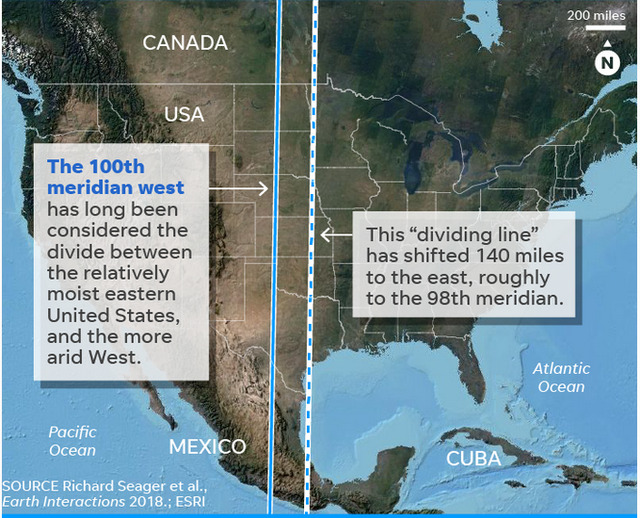

Many UC-authored scholarly publications are freely available on this site because of the UC's open access policies. The 100th meridian is a very real arid–humid divide in the physical climate and landscape, and this has exerted a powerful influence on human settlement and agricultural development. Wheat and corn cultivation preferentially occur west and east of the 100th meridian, respectively. Farms are fewer but larger west of the meridian, reflective of lower land productivity. The gradient is sharp in terms of greater fractional coverage of developed land east of the 100th meridian than to the west. The aridity gradient is realized in soil moisture and a west-to-east transition from shortgrass to tallgrass prairie. Geographical Surveys West of the 100th Meridian (U.S.): Annual report.

In 1878, the American geologist and explorer John Wesley Powell drew an invisible line in the dirta very long line. Climate change may already have started shifting the divide eastward (dotted line). In summer, the southerly flow on the western flank of the North Atlantic subtropical high has a westerly component over the western plains, bringing air from the interior southwest, but it also brings air from the Gulf of Mexico over the eastern plains, generating a west–east moisture transport and precipitation gradient. The 100th meridian west (solid line) has long been considered the divide between the relatively moist eastern United States, and the more arid West. In winter, the arid regions west of the 100th meridian are shielded from Pacific storm-related precipitation and are too far west to benefit from Atlantic storms. It is shown there is a stark east–west gradient in aridity roughly at the 100th meridian that is well expressed in hydroclimate, soil moisture, and “potential vegetation.” The gradient arises from atmospheric circulations and moisture transports. It is reexamined in terms of climate, hydrology, vegetation, land use, settlement, and the agricultural economy. It figures prominently in many other designations. The 100th Meridian, although an imaginary line on the surface of the earth, has long symbolized the end of the east and the beginning of the west. This concept remains firmly fixed in the national imagination. The storyboard, located across Wyatt Earp Boulevard from the historic Santa Fe Depot, describes the importance of the 100th Meridian to the country's history and the location of the actual marker. Western Territory of the United States, Obtained in. of Engineers, Commanding.John Wesley Powell, in the nineteenth century, introduced the notion that the 100th meridian divides the North American continent into arid western regions and humid eastern regions. 100th Meridian, Photographs Showing Landscapes, Geological, and Other Features of Portions of the. Geographical & Geological Explorations & Surveys West of the 100th Meridian.

Historic Spanish Record of the Conquest, South Side of Inscription Rock, N.M.Distant View of Camp Apache, Arizona, 1873.Cooley’s Park, Sierra Blanca Range, Arizona, 1873.North Fork Cañon, Sierra Blanca Creek, Arizona, 1873.View on Apache Lake, Sierra Blanca Range, Arizona, 1873.Apache Lake, Sierra Blanca Range, Arizona, 1873 The 100th meridian, which bisects the Great Plains and separates the arid western states from the moister eastern states, may be shifting as a result of climate change, new studies say.Snow Peaks, Bull Run Mining District, Nevada, 1871 Geological Survey officially established the 100th Meridian to mark 100 degrees of longitude west of Greenwich as the boundary between the.Black Cañon, Colorado River, Looking Below, Near Camp 7, 1871.Bluff Opposite Big Horn Camp, Black Cañon, Colorado River, 1871.

A Harvest of Death, Gettysburg, Pennsylvania, July 1863 Lost Souls Extended Version Callum Beattie, Harddope 100th Meridian Music.In a niche 50 feet above present Cañon bed., 1873 Ancient Ruins in the Cañon de Chelle, N.M.


 0 kommentar(er)
0 kommentar(er)
